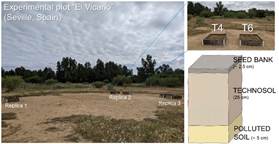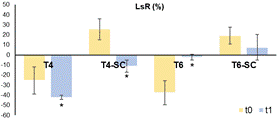INTRODUCTION
Soil contamination by potentially harmful elements (PHEs) is one of the most alarming degradation processes worldwide. Metal mining is one of the main pollutant sources, especially the mismanagement of waste derived from this activity. A notable example of the damage that can be caused by this type of contamination was the mine spill occurred in 1998 in Aznalcóllar (SW Spain), where 4.5 hm3 of acidic waters and toxic tailings were spilled into the Agrio and Guadiamar rivers (Simón et al., 2001), eventually affecting 45 km2 of soils. The consequences of this tragic environmental accident still persist to this day, with around 7% of the affected area with bare, acidic soils with high levels of some PHEs despite the implementation of one of the most ambitious soil remediation programmes ever undertaken (Martín Peinado et al., 2015; García-Carmona et al., 2019).
Rehabilitation of these contaminated areas is critical to prevent environmental degradation, as well as to control the exposure of human and other living organisms to PHEs (Pavel & Gavrilescu, 2008). Recently, one of the booming environmental rehabilitation technologies, based on sustainability and circular economy, is the use of waste-derived Technosols. This technology refers to those soils whose properties are characterised by their technical origin (Technosol "tailor made soils"; Macías, 2004). Technosols are produced mostly from waste and fulfill a specific function such as the acid neutralisation and immobilisation of PHEs, as well as the general soil functions. The effectiveness of this strategy in improving the physico-chemical and biological characteristics of mine tailings and leachates has been demonstrated in several studies using a wide range of different Technosols (Jordán et al., 2017; Asemaninejad et al., 2018; Santos et al., 2019). Likewise, Aguilar-Garrido et al. (2022) showed a high acid neutralising and immobilisation of PHEs capacity in soils affected by mining of some Technosols through laboratory assays. Therefore, here we have selected two of the best Technosols from the previous study and applied them in an in-situ soil rehabilitation experiment.
The aim of this study is to evaluate, in the short term, the changes produced in the physico-chemical and biological properties of both treated contaminated soils and Technosols.
MATERIAL AND METHODS
To remediate residually contaminated soils for more than 20 years due to the Aznalcóllar mining spill, we implemented a pilot project in the Guadiamar Green Corridor (Figure 1). About 25 cm of two Technosols (T4 and T6) were surface applied on the contaminated soils, in triplicate. Technosols were developed by mixing ex-situ contaminated soils and organic/inorganic wastes from mining (sludge rich in iron oxihydroxides and sludge from the cutting and polishing of marble), urban activity (vermicompost from gardening) in T6, and agro-industry (solid olive-mill by-product) in T4, in the proportions set out in Table 1.
Table 1 Composition of Technosols T4 and T6: % of contaminated soil and of each waste
| Technosol | PS | IO | MS | OL | VC |
| T4 | 59 | 2 | 20 | 19 | - |
| T6 | 63 | 2 | 20 | - | 15 |
PS: contaminated soil, IO: sludge rich in iron oxihydroxides; MS: sludge from marble cutting, OL: solid olive-mill by-product; VC: vermicompost from pruning and gardening
After one month of incubation in the field (t0) and 6 months of its application on the contaminated soil (t1), composite samples of each of the Technosols (T4 and T6; depth: < 25 cm), and of the contaminated soil treated below each Technosol (T4-SC and T6-SC; depth: 25 cm - 30 cm) were collected. These samples were analysed to examine for changes in soil properties (pH and EC in 1:2.5 and 1:5 soil:water extract, respectively; organic C; calcium carbonate; total N and Fe; available P; cation exchange capacity; and basal heterotrophic respiration; ISO, 2002). The mobility and bioavalibilty of PHEs was also assesed by determining the multi-elemental concentration in the total fraction (X‐ray fluorescence with NITON XL3t‐980 GOLDD+), water-soluble and available by EDTA extraction fractions (measured by PerkinElmer Avio® 500 ICP-OES). A bioassay with Lactuca sativa L. (OECD, 2003) was also carried out to evaluate the evolution of the toxicity of the soils studied. Changes in the parameters of the Technosols and the treated soils in time were evaluated using the non-parametric U Mann-Whitney test (p < 0.05).
RESULTS AND DISCUSSION
Technosols (T4 and T6) with a sandy loam-loam texture were highly carbonated, with pH close to neutral or slighthly alkaline. They also had a high total Fe and OC content, but low CEC was measured (Table 2). These soil properties and constituents play an important role in reducing the mobility and availability of PHEs in soils, as they are potential PHEs adsorbers and acidity neutralisers (Merdy et al., 2009; Aguilar-Garrido et al., 2021).
Table 2 Properties of contaminated soil and Technosols at the beginning (t0) and 6 months after installation (t1)
| T4 | T4-SC | T6 | T6-SC | |||||
| t0 | t1 | t0 | t1 | t0 | t1 | t0 | t1 | |
| pH | 7.03 a | 7.78 b | 3.60 a | 7.33 b | 7.12 a | 7.79 b | 3.60 a | 6.71 b |
| EC | 3.34 | 3.12 | 2.88 b | 2.72 a | 3.05 b | 2.73 a | 2.82 | 2.69 |
| OC | 2.92 | 2.16 | 0.45 a | 0.87 b | 2.29 | 2.39 | 0.59 a | 0.92 b |
| CO3 | 21.60 | 19.47 | 0.68 b | 0.41 a | 30.39 b | 19.10 a | 0.62 | 0.38 |
| NT | 0.20 a | 0.22 b | 0.10 | 0.10 | 0.18 | 0.20 | 0.10 | 0.10 |
| FeT | 4.58 b | 3.96 a | 4.82 b | 3.85 a | 3.63 | 3.76 | 5.11 b | 4.13 a |
| PA | 9.15 b | 3.25 a | 6.98 b | 3.42 a | 73.97 b | 13.47 a | 6.29 b | 4.41 a |
| CEC | 8.93 a | 12.10 b | 7.99 | 8.90 | 9.75 b | 7.58 a | 6.96 a | 9.27 b |
| SR | 5.30 | 4.64 | 1.61 a | 4.59 b | 4.80 | 6.38 | 2.16 | 3.69 |
EC: electrical conductivity (dS m-1); OC: organic carbon (%), CO3: calcium carbonate content (%); NT: total N content (%); FeT: total Fe content (%); PA: assimilable P (mg kg-1); CEC: cation exchange capacity (cmol(+) kg-1); SR: basal respiration (µg CO2 g soil−1 h−1). Lower-case letters indicate statistically significant differences over time.
The contaminated soil presented the same conditions observed in previous studies such as acidic pH, low OC content, low microbial activity and nutrient poverty (Table 2); as well as high concentrations of some PHEs (e.g. As, Cu, Pb, Ni and Zn) in the total, soluble and bioavailable fractions (Table 3).
Table 3 Total, water-soluble and available concentrations of metal(loid)s (mg kg-1) of contaminated soil and Technosols at the beginning (t0) and 6 months after installation (t1)
| T4 | T4-SC | T6 | T6-SC | |||||
| Total | t0 | t1 | t0 | t1 | t0 | t1 | t0 | t1 |
| As | 215.2 b | 187.0 a | 274.1 | 189.3 | 187.0 | 183.9 | 288.7 b | 234.1 a |
| Cd | <LOD | <LOD | <LOD | <LOD | <LOD | <LOD | <LOD | <LOD |
| Cu | 95.3 | 93.1 | 81.5 | 77.5 | 75.1 | 75.4 | 84.9 | 75.8 |
| Cr | 55.2 | 55.4 | 94.8 | 101.6 | 53.7 | 55.8 | 91.9 | 85.8 |
| Ni | 31.3 | 25.2 | 35.8 b | 29.9 a | 30.2 | 25.6 | 36.0 | 38.9 |
| Pb | 477.7 b | 418.6 a | 548.9 | 402.7 | 422.9 | 380.6 | 553.6 | 405.3 |
| Sb | 20.6 | 17.8 | 24.9 | 18.1 | 16.3 b | <LOD a | 22.8 | 21.4 |
| Zn | 168.1 | 151.9 | 144.9 | 167.1 | 156.9 | 167.8 | 129.0 | 134.1 |
| Water-soluble | ||||||||
| As | 0.23 a | 0.51 b | 0.20 b | 0.17 a | 0.37 a | 0.59 b | 0.20 | 0.16 |
| Cd | 0.008 | 0.004 | 0.221 b | 0.000 a | 0.010 b | 0.005 a | 0.175 | 0.042 |
| Cu | 0.47 b | 0.19 a | 3.39 b | 0.08 a | 0.30 b | 0.07 a | 3.20 b | 0.14 a |
| Cr | 0.017 b | 0.000 a | 0.057 b | 0.000 a | 0.014 b | 0.000 a | 0.044 b | 0.003 a |
| Ni | 0.041 b | 0.012 a | 1.398 b | 0.000 a | 0.017 b | 0.000 a | 1.177 | 0.351 |
| Pb | <LOD | <LOD | <LOD | <LOD | <LOD | <LOD | <LOD | <LOD |
| Sb | 0.123 | 0.153 | 0.055 | 0.049 | 0.131 b | 0.107 a | 0.031 | 0.051 |
| Zn | 0.26 b | 0.10 a | 35.54 b | 0.04 a | 0.16 b | 0.05 a | 27.79 | 6.75 |
| Available - EDTA extraction | ||||||||
| As | 0.90 a | 2.42 b | 2.45 | 2.58 | 2.54 a | 3.48 b | 2.42 | 3.73 |
| Cd | 0.38 | 0.34 | 0.28 | 0.29 | 0.38 | 0.40 | 0.24 | 0.23 |
| Cu | 16.18 | 13.11 | 19.29 | 18.38 | 15.14 b | 13.68 a | 17.88 | 15.25 |
| Cr | 0.18 b | 0.12 a | 0.18 | 0.27 | 0.21 b | 0.12 a | 0.15 | 0.20 |
| Ni | 0.50 b | 0.27 a | 1.55 b | 0.71 a | 0.57 b | 0.27 a | 1.31 | 0.81 |
| Pb | 0.69 | 0.09 | 0.25 | 1.67 | 0.71 b | 0.35 a | 0.71 | 0.55 |
| Sb | 0.23 | 0.31 | 0.15 | 0.28 | 0.25 | 0.33 | 0.18 | 0.27 |
| Zn | 31.51 | 21.94 | 38.47 b | 17.44 a | 37.29 b | 28.82 a | 29.88 | 18.33 |
LOD: Level of detection. Lower-case letters indicate statistically significant differences over time.
During these six months, with the treatment of Technosols, the contaminated soil was reverting its adverse conditions. Most notably, the strong acidic pH condition has been neutralised. In fact, a reduction in the calcium carbonate content was observed in the Technosols, especially at T6, as a result of the reaction of the latter buffering the soil pH. Likewise, a slight enrichment in OC is occurring in the underlying contaminated soil.
Regarding the mobility and availability of PHEs in the contaminated soil, there were significant reductions in the soluble fraction of Cd, Cu, Cr, Ni and Zn in both Technosols (higher reduction in T4). While in the available fraction no major changes have been observed yet. However, the toxicity bioassay with lettuce showed that the potential toxicity in the contaminated soil is decreasing, although in the T6-treated soil it was not statistically significant (Figure 2).
CONCLUSIONS
The application of Technosols on residually contaminated soils has led to a significant improvement in the physico-chemical and biological quality of the soils only six months later. Thus, expectations for further progress in the soil remediation process over time are high. In fact, in future studies, the development of a vegetation cover on the technosols is expected, which has not yet occurred due to the sampling times (April-October).
















